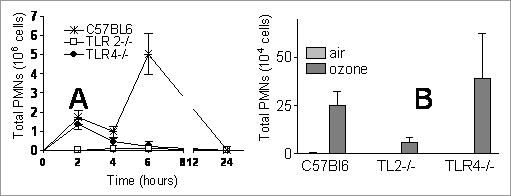Print version
Search Pub Med
Critical role of toll like receptor 2 in the sensing of oxidant induced inflammation Toll like receptors are critical sensors of pathogens in the innate immune system. There are 10 TLR homologues in man. The best studied are TLR4 and TLR2 which are activated, and therefore, sense Gram-negative and Gram-positive bacteria respectively. However, there is a strong likelihood that TLRs mediate aseptic inflammation, and that endogenous host derived ligands exist for TLRs. In the current study we have extended this and addressed the possibility that oxidants can act as ‘ligands’ for TLRs. Specifically, we have used two in vivo models, both of which are driven directly by an oxidant insult, to illustrate the essential role of TLR2 in the resultant inflammation.Wild type (C57b/L6J) or knock out (TLR2-/- or TLR4-/-) were treated with smoke extract (Paul-Clark et al., 2005; 10% ip; 2-24 hours) or inhaled ozone (Hisada et al., 1999; 3 hours) for different periods up to 24 hours. Inflitrated PMNs were retrieved from theairway or peritenium by saline washing and counted using Turk’s solution.
Figure 1: A, Soluble smoke extract (which causes inflammation via oxidant stress; Paul-Clark et al., 2005), or B, the oxidant ozone increase leukocyte infiltration into the peretenium or airways respectively. However, at 3 hours after stimulation leukocyte recruitment is absent in mice lacking the TLR2 gene (TLR2-/-). A, At 6 hours after stimulation, leukocyte recruitment was also absent in TLR4 deficient mice. All experiments are n=6-9. Smoke extract or ozone insult was associated with increased recruitment of leukoctyes in C57B/L6J mice. However, in either model, this response was absent in mice lacking TLR2 receptors. In smoke-induced oxidant insult, inflammation at 6 hours was also absent in mice lacking TLR4 receptors. These observations show, for the first time, that TLR2 receptors are involved in sensing the very early events of oxidant-induced inflammatory responses. They also show that, in vivo, TLR4 may play a role in subsequent oxidant induced inflammatory responses with possible cross talk between the receptors. These observations have important implications for our understanding of TLR biology and expand our expectations of the importance of this group of molecules. Walters MJ, Paul-Clark MJ, Ito K, Adcock IM, Mitchell MJ. (2005) Mol Pharmacol. under revision. Funded by BHF; Wellcome trust . |


